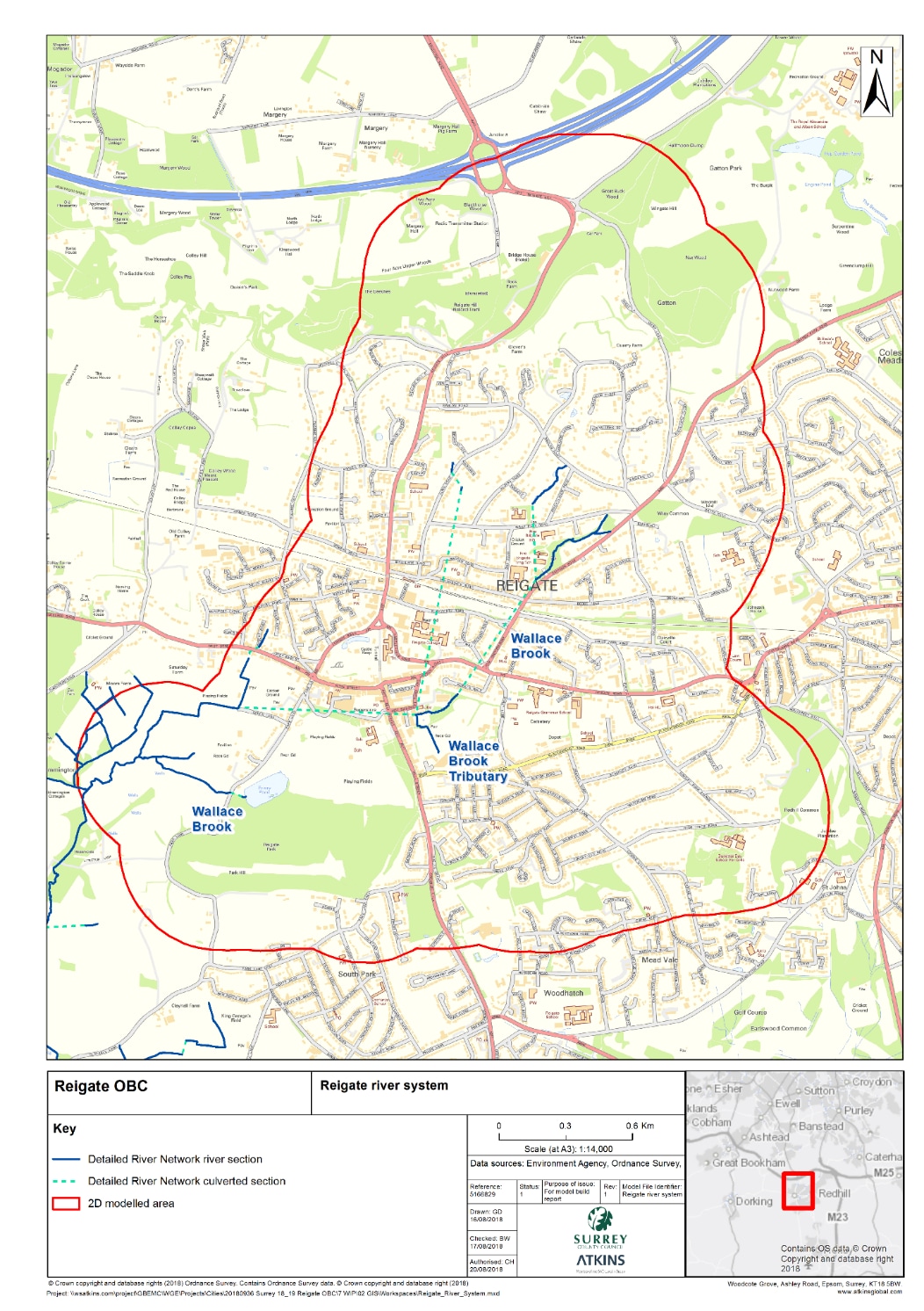ATKINS
How Atkins modeled rainfall runoff across different soil types in InfoWorks ICM to mitigate flood risks in Reigate
STORM, SEWER, FLOOD
Share this story
Summary
Over the last 20 years, the town center of Reigate in the southern English county of Surrey has flooded on a regular basis due to a combination of fluvial flooding from the Wallace Brook, surface water, and foul flooding. One specific difficulty they faced in tackling the situation were siltation issues in the brook itself. They needed a way to accurately account for not just soil in and around the brook, but for the different types of soil all around the area so they could have the right information to solve the problem.

Half a month's rainfall in one day
When a rainfall event in August 2015 saw 37 mm of rainfall in one day - almost half of the area's expected monthly rainfall - shops and roads in the town center were flooded, restricting access to homes and care homes. This event spurred Surrey County Council (SCC) to commission Atkins, one of the world’s most respected design, engineering, and project management consultants, to undertake a flood alleviation study for Reigate.
Ruchi Sayal, a hydraulic modeler on Atkins’ engineering, design, and project management team, turned to InfoWorks ICM to build a comprehensive catchment model of the river that also included surface water and foul water components. She aimed to create a model that would synthesize data about the Wallace Brook and its tributary, the river Mole, along with nearby ponds and other watercourse structures.
They set a foundation by creating a 2D ground mesh model using LiDAR data to show surface features, with drainage systems for both surface water and foul completing the picture.

Deciding on an infiltration model approach
The infiltration of rainwater into the soil is an important consideration for modeling the effects of direct rainfall runoff. Understanding the specific characteristics of the soil plays a big part in predicting how it will infiltrate the catchment.
InfoWorks ICM utilizes multiple infiltration models to calculate the infiltration in the catchment, among them Horton, Green Ampt, Fixed Infiltration and Constant Infiltration. Ruchi opted for Green Ampt. “Green Ampt considers a wide range of soil characteristics. This gives a more realistic representation over the catchment," she explains. "Furthermore, Green Ampt was used for a catchment model of an adjacent area built for the environment agency, which was calibrated to actual conditions.”
They began with data from the British Geological Survey (BGS) website to help them understand the broader soil distribution of the UK. Then, they zoomed in and compared Reigate’s soil composition with the geology of the adjacent catchment.
Plugging in more information to refine the model
Hydraulic conductivity is the rate at which water is likely to infiltrate the soil, with impermeable soil types like clay representing a low number and sandier soil representing a higher rate of water conductivity. The Green Ampt parameters corresponded to clay loam for the Reigate catchment, so they initially adopted these parameters across the whole of the catchment. They calculated a low value of hydraulic conductivity of around 2mm per hour.
Verification with historic flood events was very important to them so they could establish their model’s reliability. However, they had limited gauge data for the Reigate catchment, so they weren't able to fully calibrate it based on historic flood events. When comparing the initial model results to general historical data, the expected areas were modelled to flood. However, for a 20% chance of a (1 in 5 annual probability) flood event, the model showed that over 30 properties would flood to over 1 m depth internally. This extensive, regular and severe flooding was deemed unrealistic.
They decided to investigate the different soil types within the catchment in more detail. Local bore holes on the BGS website indicated that the southern part of the catchment had a sandier soil type than the clay loam that formed the basis of the first modeling analysis. This additional information altered the hydraulic conductivity value from as low as ~2mm/hour for clay loam to as high as ~128mm/hour for sandy loam.
The updated model results verified well, and expected areas were modelled to flood. However, applying a 5% (1 in 20 annual probability) rainfall event didn’t activate significant flow routes which had been historically observed in the center of Reigate.
“It can be difficult to visualise the full picture, but ICM was very useful for me to see the flood risk in the catchment. At first I was skeptical as to whether the model would run, but it did. I found ICM’s stability really impressive.”
—Ruchi Sayal, hydraulic modeller, Atkins
Going deeper on soil types for the ‘Goldilocks’ solution
They decided to undertake a third stage of model refinement, this time to take into account the urban character of the catchment in the center of Reigate. Here, soil would be compacted, which would affect the infiltration rate. The catchment was divided into three sectors. The top, northern sector was clay loam, the bottom, southern sector a more sandy soil as identified by the BGS bore holes, and the large, central middle sector showed the urban nature of the town center.
In this final set up, the parameters were varied not only to match the different soils but the impact on hydraulic connectivity of soil compaction, construction, and urbanisation. Using research that suggested that these factors can reduce infiltration rates by 70-80%, Ruchi modelled the catchment based on the three different soil types likely to affect infiltration across the area.
Ruchi’s decision to take a more detailed look at the effect of soil type on rainfall runoff infiltration paid off. The results from the revised model verified well. The expected areas were modelled to flood, and depths were verified by reported incidents of flooding.
In the first model, which utilized a uniform soil type across the whole catchment, any flood alleviation solution would only have taken a low conductivity soil into account. The amount of runoff infiltrating into the soil would be too low, and so any solution would have been over-engineered to handle more water than would actually be the case. Overestimating risk can lead to models being unbelievable, undermining the evidence base used to justify schemes, which would make consulting with communities at risk more difficult.
Although the second model differentiated between soil types, the large central area would have returned a high level of infiltration that didn’t reflect reality. This could lead them underestimate flood risk and potential damage to property.
The third model set up, the ‘Goldilocks’ solution, proved to be just right. It represented the reality of the situation across the catchment and provided a better understanding of the flood risk areas and mechanisms. As Ruchi puts it, “Modellers always have to make decisions about how to make best use of the data they have and the level of detail to go into. The Reigate ICM posed a key challenge to get the right balance between being proportionate and including sufficient detail to build a model giving results that we were confident in.”

Reigate ICM 2D model extent (red boundary). Image courtesy of Atkins.
A successful model leads to a happy client
Atkins is a long-standing user of InfoWorks ICM, and Ruchi is an experienced hydraulic modeller proficient in many different types of software, but this was the first time she had used InfoWorks ICM. She was immediately impressed: “These big catchment areas are complicated," she says. “At first, I was skeptical as to whether the model would run, but it did. I found ICM’s stability really impressive.”
Being able to bring everything together in one place was a big help. “It can be difficult to visualise the full picture, but ICM was very useful for me to see the flood risk. InfoWorks ICM shows where everything is in the catchment," she explains. “The tools in ICM to customise scripts made my work really fast and efficient.”
All of her diligent work was well-received by Surrey County Council. “They were happy with the result from the model,” she says. “The work we undertook with InfoWorks ICM has shown that we were justified in using the best modelling tools to get the best result."
Advice for water professionals
Visit our water blog for ideas and insights: